Determination of the Main Factors Influencing the Chemical Composition of Atmospheric Deposition in the Territory of the Southern Baikal Region (Eastern Siberia, Russia)
Abstract
1. Introduction
2. Study Area
3. Methodological Approach
4. Results
4.1. Chemical Composition of Precipitation
4.2. Selection of Tracer Substances
4.3. Geographic Zoning to Categorize Source Groups
- Formation conditions: Air masses are formed under the influence of large anticyclonic formations established over the territory of Eastern Siberia. They pass over the areas with high anthropogenic load—the cities of Krasnoyarsk, Irkutsk, Angarsk, Shelekhov, Sayansk, Bratsk, Cheremkhovo, Gusinoozersk, and Ulan-Ude.
- Chemical composition: The following ions predominate: SO42−, NH4+, and NO3− (more than 40–50% of the total soluble content), indicating a significant impact of industrial and motor vehicle emissions.
- Features: Characterized by a stable atmosphere and the presence of jet streams at the upper boundary of the nocturnal atmospheric boundary layers at altitudes of 200–500 m above ground level.
- Formation conditions: Air masses are formed over the territory of Kazakhstan and Mongolia.
- Chemical composition: Terrigenous elements predominate—Ca2+, HCO3−, Cl−, K+, and Mg2+. The ratio [Ca2+, HCO3−, Cl−, K+, Mg2+]/[SO42−, NH4+, NO3−] is above 1, indicating the influence of aeolian transport (dust storms) and other natural factors.
- Features: This group of atmospheric precipitation shows less influence from anthropogenic sources and more influence from natural processes.
- Formation conditions: Air masses are formed in areas remote from large anthropogenic sources of pollution. The main influence is exerted by local natural conditions and meteorological parameters—temperature regime, wind speeds, and downward flows.
- Chemical composition: Characterized by low mineralization. Natural components prevail, and the pH value of atmospheric precipitation is low at 5.1–5.5.
- Features: This group of precipitation is the most “clean” among all those considered above and characterizes the background composition of atmospheric deposition without significant influence of human activity.
- Formation conditions: Air masses are formed over large areas of forest fires during the warm season.
- Chemical composition: Increased content of biomass combustion products, ions of K+, NH4+, SO42−, and NO3−. Atmospheric precipitation mineralization is greatly increased by the release of combustible materials during fires.
- Features: Wildfires can significantly alter the chemical composition of precipitation by adding a variety of organic compounds and carbon-containing particles.
5. Discussion
6. Conclusions
Author Contributions
Funding
Institutional Review Board Statement
Informed Consent Statement
Data Availability Statement
Acknowledgments
Conflicts of Interest
References
- Bruintjes, R.T. A review of cloud seeding experiments to enhance precipitation and some new prospects. Bull. Am. Meteorol. Soc. 1999, 80, 805–820. [Google Scholar] [CrossRef]
- Al Hosari, T.; Al Mandous, A.; Wehbe, Y.; Shalaby, A.; Al Shamsi, N.; Al Naqbi, H.; Farrah, S. The UAE cloud seeding program: A statistical and physical evaluation. Atmosphere 2021, 12, 1013–1030. [Google Scholar] [CrossRef]
- Abshaev, A.M.; Flossmann, A.; Siems, S.T.; Prabhakaran, T.; Yao, Z.; Tessendorf, S. Rain enhancement through cloud seeding. In Unconventional Water Resources; Springer: Berlin/Heidelberg, Germany, 2022; pp. 21–49. [Google Scholar]
- Szwed, M.; Kozłowski, R. Snow cover as an indicator of dust pollution in the area of exploitation of rock materials in the Świętokrzyskie Mountains. Atmosphere 2022, 13, 409–419. [Google Scholar] [CrossRef]
- Zhang, H.; Zhao, Z.; Cai, A.; Liu, B.; Wang, X.; Li, R.; Wang, Q.; Zhao, H. Source apportionment of heavy metals in wet deposition in a typical industry city based on multiple models. Atmosphere 2022, 13, 1716–1732. [Google Scholar] [CrossRef]
- Bhaskar, V.V.; Safai, P.D.; Mukherjee, S. Hydrochemistry of atmospheric precipitation over an urban station in the peninsular India: Assessment of the long-term data. Atmos. Pollut. Res. 2022, 13, 101343. [Google Scholar] [CrossRef]
- Zeng, J.; Han, G. Rainwater chemistry reveals air pollution in a Karst forest: Temporal variations, source apportionment, and implications for the forest. Atmosphere 2020, 11, 1315–1333. [Google Scholar] [CrossRef]
- Górka, M.; Pilarz, A.; Modelska, M.; Drzeniecka-Osiadacz, A.; Potysz, A.; Widory, D. Urban Single Precipitation Events: A Key for Characterizing Sources of Air Contaminants and the Dynamics of Atmospheric Chemistry Exchanges. Water 2024, 16, 3701–3720. [Google Scholar] [CrossRef]
- Chudaeva, V.A.; Chudaev, O.V.; Yurchenko, S.G. Features of chemical composition of atmospheric precipitation in the south of the Far East. Water Resour. 2008, 35, 60–71. [Google Scholar] [CrossRef]
- Keeler, G.J.; Landis, M.S.; Norris, G.A.; Christianson, E.M.; Dvonch, J.T. Sources of mercury wet deposition in Eastern Ohio, USA. Environ. Sci. Technol. 2006, 40, 5874–5881. [Google Scholar] [CrossRef]
- Gorham, E. Acid precipitation and its influence upon aquatic ecosystems—An overview. Water Air Soil Pollut. 1976, 6, 457–481. [Google Scholar] [CrossRef]
- Gunn, J.M.; Keller, W. Effects of ice and snow cover on the chemistry of nearshore lake water during spring melt. Ann. Glaciol. 1985, 7, 208–212. [Google Scholar] [CrossRef][Green Version]
- Lovett, G.M.; Tear, T.H.; Evers, D.C.; Findlay, S.E.; Cosby, B.J.; Dunscomb, J.K.; Weathers, K.C. Effects of air pollution on ecosystems and biological diversity in the eastern United States. Ann. N. Y. Acad. Sci. 2009, 1162, 99–135. [Google Scholar] [CrossRef]
- Wedin, D.A.; Tilman, D. Influence of nitrogen loading and species composition on the carbon balance of grasslands. Science 1996, 274, 1720–1723. [Google Scholar] [CrossRef]
- Gavrilaș, S.; Burescu, F.-L.; Chereji, B.-D.; Munteanu, F.-D. The Impact of Anthropogenic Activities on the Catchment’s Water Quality Parameters. Water 2025, 17, 1791–1815. [Google Scholar] [CrossRef]
- Galloway, J.N.; Likens, G.E.; Keene, W.C.; Miller, J.M. The composition of precipitation in remote areas of the world. J. Geophys. Res. Ocean. 1982, 87, 8771–8786. [Google Scholar] [CrossRef]
- Kawamura, G.; Bagarinao, T.; Yong, A.S.K.; Chen, C.Y.; Noor, S.N.M.; Lim, L.S. Low pH affects survival, growth, size distribution, and carapace quality of the postlarvae and early juveniles of the freshwater prawn Macrobrachium rosenbergii de Man. Ocean Sci. J. 2015, 50, 371–379. [Google Scholar] [CrossRef]
- Baker, J.P.; Bernard, D.P.; Christensen, S.W.; Sale, M.J.; Freda, J.; Heltcher, K.; Warren-Hicks, W. Biological Effects of Changes in Surface Water Acid-Base Chemistry; Oak Ridge National Lab. (ORNL): Oak Ridge, TN, USA, 1990; (No. ORNL/M-1086). [Google Scholar]
- Augustaitis, A.; Augustaitienė, I.; Kliučius, A.; Pivoras, G.; Šopauskienė, D.; Girgždienė, R. The seasonal variability of air pollution effects on pine conditions under changing climates. Eur. J. For. Res. 2010, 129, 431–441. [Google Scholar] [CrossRef]
- Etzold, S.; Ferretti, M.; Reinds, G.J.; Solberg, S.; Gessler, A.; Waldner, P.; de Vries, W. Nitrogen deposition is the most important environmental driver of growth of pure, even-aged and managed European forests. For. Ecol. Manag. 2020, 458, 117762. [Google Scholar] [CrossRef]
- Commission of the European Communities. Communication from the Commission to the European Parliament, the Council, the European Economic and Social Committee and the Committee of the Regions: A Strategy for ICT R&D and Innovation in Europe: Raising the Game; Office for Official Publications of the European Communities: Luxembourg, 2009; Volume 116. [Google Scholar]
- Sillmann, J.; Aunan, K.; Emberson, L.; Büker, P.; Van Oort, B.; O’Neill, C.; Brisebois, A. Combined impacts of climate and air pollution on human health and agricultural productivity. Environ. Res. Lett. 2021, 16, 093004. [Google Scholar] [CrossRef]
- Elad, Y.; Pertot, I. Climate Change Impacts on Plant Pathogens and Plant Diseases. J. Crop Improv. 2014, 28, 99–139. [Google Scholar] [CrossRef]
- Izah, S.C.; Ogwu, M.C.; Shahsavani, A. Air Pollutants in the Context of One Health. In The Handbook of Environmental Chemistry; Springer: Berlin/Heidelberg, Germany, 2024; Volume 134. [Google Scholar]
- Sawyer, W.E.; Aigberua, A.O.; Nwodo, M.U.; Akram, M. Overview of Air Pollutants and Their One Health Effects. In Air Pollutants in the Context of One Health: Fundamentals, Sources, and Impacts; Springer: Berlin/Heidelberg, Germany, 2024; pp. 3–30. [Google Scholar]
- Khodzher, T.V.; Sorokovikova, L.M. An assessment of the entry of soluble substances from the atmosphere and with the river runoff into Lake Baikal. Geogr. Prir. Resur. 2007, 3, 185–191. [Google Scholar]
- Netsvetaeva, O.G.; Chipanina, E.V.; Obolkin, V.A.; Zimnik, E.A.; Sez’ko, N.P.; Lopatina, I.N.; Khodzher, T.V. Peculiarities of chemistry of atmospheric precipitations at stations Listvyanka (Irkutsk region) and Primorskaya Primorye territory. Opt. Atmos. Ocean 2013, 26, 466–471. [Google Scholar]
- Urbanaviciene, I.N. Monitoring the state of epiphytic lichen cover in fir forests of the Baikal Reserve. Nat. Baikal Sib. Proc. Nat. Reserves Natsio 2017, 170–179. [Google Scholar]
- Mukhin, D.P.; Musatov, K.E.; Alekseev, N.K. Condition of fir plantations of the northern macro-slope of Khamar-Daban. Baikal Nat. Biosph. Reserve 2015, 43, 166–169. [Google Scholar]
- Belova, N.A.; Morozova, T.I. Dynamics of forest pathology condition of fir stands of the Baikal Nature Reserve (1983–2015). For. Bull. 2018, 22, 5–15. [Google Scholar]
- Tomberg, I.V.; Sorokovikova, L.M.; Netsvetayeva, O.G.; Sezko, N.P.; Zhuchenko, N.A. Chemical composition and acidification trend of snow and tributary waters of South Baikal. Opt. Atmos. Ocean 2016, 29, 516–520. [Google Scholar]
- Obolkin, V.; Khodzher, T.; Sorokovikova, L.; Tomberg, I.; Netsvetaeva, O.; Golobokova, L. Effect of long-range transport of sulphur and nitrogen oxides from large coal power plants on acidification of river waters in the Baikal region, East Siberia. Int. J. Environ. Stud. 2016, 73, 452–461. [Google Scholar] [CrossRef]
- Obolkin, V.A.; Volkova, E.A.; Ohira, S.I.; Toda, K.; Netsvetaeva, O.G.; Chebunina, N.S.; Nosova, V.V.; Bondarenko, N.A. The role of atmospheric precipitation in the under-ice blooming of endemic dinoflagellate Gymnodinium baicalense var. minor Antipova in Lake Baikal. Limnol. Freshw. Biol. 2019, 345–352. [Google Scholar]
- Bondarenko, N.A.; Tomberg, I.V.; Shirokaya, A.A.; Belykh, O.I.; Tikhonova, I.V.; Fedorova, G.A.; Timoshkin, O.A. Dolichospermum lemmermannii (Nostocales) bloom in world’s deepest Lake Baikal (East Siberia): Abundance, toxicity and factors influencing growth. Limnol. Freshw. Biol. 2021, 4, 1101–1110. [Google Scholar] [CrossRef]
- Malnik, V.V.; Gorshkova, A.S.; Tomberg, I.V.; Netsvetaeva, O.G.; Molozhnikova, E.V.; Timoshkin, O.A. Coastal Water Quality in Lake Baikal in Bol’shie Koty Bay, Determined by the Effect of Atmospheric Precipitation and the Survival of Indicator Microorganisms. Water Resour. 2024, 51, 267–283. [Google Scholar] [CrossRef]
- Svv, D.R.; Al-Rashidi, A.; Sabarathinam, C.; Alsabti, B.; Al-Wazzan, Y.; Kumar, U.S. Temporal and spatial shifts in the chemical composition of urban coastal rainwaters of Kuwait: The role of air mass trajectory and meteorological variables. Sci. Total Environ. 2023, 899, 165649. [Google Scholar] [CrossRef] [PubMed]
- Afanasyev, A.N. Water Resources and Water Balance of the Lake Baikal Basin; Science; Siberian Branch: Novosibirsk, USSR, 1976; pp. 1–238. [Google Scholar]
- Obolkin, V.A.; Netsvetaeva, O.G.; Golobokova, L.P.; Potemkin, V.L.; Zimnik, E.A.; Filippova, U.G.; Khodzher, T.V. Results of long-term studies of acid deposition in the area of South Baikal. Geogr. Nat. Resour. 2013, 2, 66–73. [Google Scholar]
- Potemkina, T.; Potemkin, V. Extreme phenomena in the Lake Baikal basin: Tropical nights and hot days as indicators of climate warming (Eastern Siberia, Russia). Theor. Appl. Climatol. 2024, 155, 6581–6590. [Google Scholar] [CrossRef]
- Saneev, B.G.; Ivanova, I.Y.; Maisyuk, E.P.; Tuguzova, T.F.; Ivanov, R.A. Energy infrastructure of the central ecological zone of the Baikal natural territory: Impact on the natural environment and ways to reduce it. Geogr. Nat. Resour. 2016, 5, 218–224. [Google Scholar]
- Obolkin, V.; Molozhnikova, E.; Shikhovtsev, M.; Netsvetaeva, O.; Khodzher, T. Sulfur and nitrogen oxides in the atmosphere of Lake Baikal: Sources, automatic monitoring, and environmental risks. Atmosphere 2021, 12, 1348. [Google Scholar] [CrossRef]
- Shikhovtsev, M.Y.; Molozhnikova, Y.V.; Obolkin, V.A.; Potemkin, V.L.; Lutskin, E.S.; Khodzher, T.V. Features of Temporal Variability of the Concentrations of Gaseous Trace Pollutants in the Air of the Urban and Rural Areas in the Southern Baikal Region (East Siberia, Russia). Appl. Sci. 2024, 14, 8327. [Google Scholar] [CrossRef]
- Sharma, A.; Khare, P.; Singh, N.; Tiwari, S.; Chate, D.M.; Kumar, R. Anthropogenic aerosols in precipitation over the Indo-Gangetic basin. Environ. Geochem. Health 2023, 45, 961–980. [Google Scholar] [CrossRef]
- Celle-Jeanton, H.; Travi, Y.; Loÿe-Pilot, M.D.; Huneau, F.; Bertrand, G. Rainwater chemistry at a Mediterranean inland station (Avignon, France): Local contribution versus long-range supply. Atmos. Res. 2009, 91, 118–126. [Google Scholar] [CrossRef]
- Norwegian Institute for Air Research. EMEP Manual for Sampling and Chemical Analysis; Norwegian Institute for Air Research: Kjeller, Norway, 1995; p. 303. [Google Scholar]
- EANET. Technical Manual for Wet Deposition Monitoring in East Asia; Network Center for EANET Press: Niigata, Japan, 2010; p. 113. [Google Scholar]
- Mathur, K. A Step-by-Step Guide to Exploratory Factor Analysis; Vidya Books: Meerut, India, 2022. [Google Scholar]
- Draxler, R.R.; Hess, G.D. An overview of the HYSPLIT_4 modelling system for trajectories. Aust. Meteorol. Mag. 1998, 47, 295–308. [Google Scholar]
- Stein, A.F.; Draxler, R.R.; Rolph, G.D.; Stunder, B.J.; Cohen, M.D.; Ngan, F. NOAA’s HYSPLIT atmospheric transport and dispersion modeling system. Bull. Am. Meteorol. Soc. 2015, 96, 2059–2077. [Google Scholar] [CrossRef]
- Hsu, Y.K.; Holsen, T.M.; Hopke, P.K. Comparison of hybrid receptor models to locate PCB sources in Chicago. Atmos. Environ. 2003, 37, 545–562. [Google Scholar] [CrossRef]
- Li, C.; Ling, X.; Liu, W.; Tang, Z.; Zhuang, Q.; Fang, M. Long-Term Spatiotemporal Variability and Source Attribution of Aerosols over Xinjiang, China. Remote Sens. 2025, 17, 2207–2228. [Google Scholar] [CrossRef]
- Hu, K.; Liao, H.; Liu, D.; Jin, J.; Chen, L.; Li, S.; Zhao, D. A Novel Method for Quantifying the Contribution of Regional Transport to PM2.5 in Beijing (2013–2020): Combining Machine Learning with Concentration-Weighted Trajectory Analysis. Geosci. Model Dev. Discuss. 2024, 8, 1–20. [Google Scholar] [CrossRef]
- Ghosh, S.; Biswas, J.; Guttikunda, S.; Roychowdhury, S.; Nayak, M. An investigation of potential regional and local source regions affecting fine particulate matter concentrations in Delhi, India. J. Air Waste Manag. Assoc. 2015, 65, 218–231. [Google Scholar] [CrossRef]
- Molozhnikova, Y.V.; Shikhovtsev, M.Y.; Netsvetaeva, O.G.; Khodzher, T.V. Ecological Zoning of the Baikal Basin Based on the Results of Chemical Analysis of the Composition of Atmospheric Precipitation Accumulated in the Snow Cover. Appl. Sci. 2023, 13, 8171. [Google Scholar] [CrossRef]
- Semenov, M.Y.; Silaev, A.V.; Semenov, Y.M.; Begunova, L.A.; Semenov, Y.M. Identifying and characterizing critical source areas of organic and inorganic pollutants in urban agglomeration in Lake Baikal watershed. Sustainability 2022, 14, 14827. [Google Scholar] [CrossRef]
- Dadashazar, H.; Ma, L.; Sorooshian, A. Sources of pollution and interrelationships between aerosol and precipitation chemistry at a central California site. Sci. Total Environ. 2019, 651, 1776–1787. [Google Scholar] [CrossRef]
- Talovskaya, A.V.; Adil’bayeva, T.E.; Yazikov, E.G. Monitoring For Elemental Composition Of Particulate Matter Deposited In Snow Cover Around Coal-Fired Thermal Power Plant Karaganda, Central Kazakhstan. Geogr. Environ. Sustain. 2024, 16, 180–192. [Google Scholar] [CrossRef]
- Sun, S.; Liu, S.; Li, L.; Zhao, W. Components, acidification characteristics, and sources of atmospheric precipitation in Beijing from 1997 to 2020. Atmos. Environ. 2021, 266, 118707. [Google Scholar] [CrossRef]
- Brugnone, F.; D’Alessandro, W.; Parello, F.; Liotta, M.; Bellomo, S.; Prano, V.; Li Vigni, L.; Sprovieri, M.; Calabrese, S. Atmospheric Deposition around the Industrial Areas of Milazzo and Priolo Gargallo (Sicily–Italy)—Part A: Major Ions. Int. J. Environ. Res. Public Health 2023, 20, 3898–3923. [Google Scholar] [CrossRef]
- Cheng, I.; Xu, X.; Zhang, L. Overview of receptor-based source apportionment studies for speciated atmospheric mercury. Atmos. Chem. Phys. 2015, 15, 7877–7895. [Google Scholar] [CrossRef]
- Amato, F.; Viana, M.; Richard, A.; Furger, M.; Prévôt, A.S.H.; Nava, S.; Lucarelli, F.; Bukowiecki, N.; Alastuey, A.; Reche, C.; et al. Size and time-resolved roadside enrichment of atmospheric particulate pollutants. Atmos. Chem. Phys. 2011, 11, 2917–2931. [Google Scholar] [CrossRef]
- Sricharoenvech, P.; Edwards, R.; Yaşar, M.; Gay, D.A.; Schauer, J. Understanding the origin of wet deposition black carbon in North America during the fall season. Environments 2025, 12, 58. [Google Scholar] [CrossRef]
- Anselmo-Moreira, F.; da Silva Pedrosa, G.; da Silva, I.L.; do Nascimento, A.; dos Santos, T.C.; Catharino, E.L.M.; de Souza, S.R. Biogenic volatile organic compound (BVOC) emission profiles from native Atlantic Forest trees: Seasonal variation and atmospheric implications in southeastern Brazil. Urban For. Urban Green. 2025, 104, 128645. [Google Scholar] [CrossRef]
- Charron, A.; Plaisance, H.; Sauvage, S.; Coddeville, P.; Galloo, J.C.; Guillermo, R. A Methodology for Examining the Long-Range Transport and the Source-Receptor Relationships for Acidic Pollutants; WIT Transactions on Ecology and the Environment; WIT Press: Billerica, MA, USA, 2024; Volume 37. [Google Scholar]
- Cao, Y.Z.; Wang, S.; Zhang, G.; Luo, J.; Lu, S. Chemical characteristics of wet precipitation at an urban site of Guangzhou, South China. Atmos. Res. 2009, 94, 462–469. [Google Scholar] [CrossRef]
- Bani, P.; Oppenheimer, C.; Tsanev, V.; Scaillet, B.; Primulyana, S.; Saing, U.B.; Marlia, M. Modest volcanic SO2 emissions from the Indonesian archipelago. Nat. Commun. 2022, 13, 3366–3381. [Google Scholar] [CrossRef]
- Heo, J.; McGinnis, J.E.; de Foy, B.; Schauer, J.J. Identification of potential source areas for elevated PM2.5, nitrate and sulfate concentrations. Atmos. Environ. 2013, 71, 187–197. [Google Scholar] [CrossRef]
- Duan, F.; Liu, X.; Yu, T.; Cachier, H. Identification and estimate of biomass burning contribution to the urban aerosol organic carbon concentrations in Beijing. Atmos. Environ. 2004, 38, 1275–1282. [Google Scholar] [CrossRef]
- Golobokova, L.P.; Khodzher, T.V.; Zhamsueva, G.S.; Zayakhanov, A.S.; Starikov, A.; Khuriganova, O.I. Variability of the chemical composition of the atmospheric aerosol in the coastal zone of the southern basin of Lake Baikal (East Siberia, Russia). Atmosphere 2022, 13, 1090. [Google Scholar] [CrossRef]
- State Report. On the State and Protection of the Environment of the Russian Federation in 2023; Ministry of Natural Resources and Environment of Russia: Moscow, Russia, 2024. [Google Scholar]
- Osipova, O.P.; Osipov, E.Y. Atmospheric circulation processes and precipitation regime in the Northern Part of the Baikal Mountain Region. Russ. Meteorol. Hydrol. 2019, 44, 695–703. [Google Scholar] [CrossRef]
- Antokhina, O.Y.; Antokhin, P.N.; Devyatova, E.V.; Mordvinov, V.I. Main precipitation regimes in the south of Eastern Siberia and Mongolia in July. Atmos. Ocean Opt. 2018, 31, 443–450. [Google Scholar]
- Vinogradova, G.M.; Zavalishin, N.N.; Kuzin, V.I. Intra-century climate changes in Eastern Siberia. Atmos. Ocean Opt. 2002, 15, 408–411. [Google Scholar]
- Shimaraev, M.N.; Starygina, L.N. Zonal atmospheric circulation, climate and hydrological processes in Baikal (1968–2007). Geogr. Nat. Resour. 2010, 3, 62–84. [Google Scholar] [CrossRef]
- Shikhovtsev, A.Y. Reference optical turbulence characteristics at the Large Solar Vacuum Telescope site. Publ. Astron. Soc. Jpn. 2024, 76, 538–549. [Google Scholar] [CrossRef]
- Shikhovtsev, A.Y.; Kovadlo, P.G.; Lezhenin, A.A.; Gradov, V.S.; Zaiko, P.O.; Khitrykau, M.A.; Shikhovtsev, M.Y. Simulating atmospheric characteristics and daytime astronomical seeing using Weather Research and Forecasting Model. Appl. Sci. 2023, 13, 6354. [Google Scholar] [CrossRef]
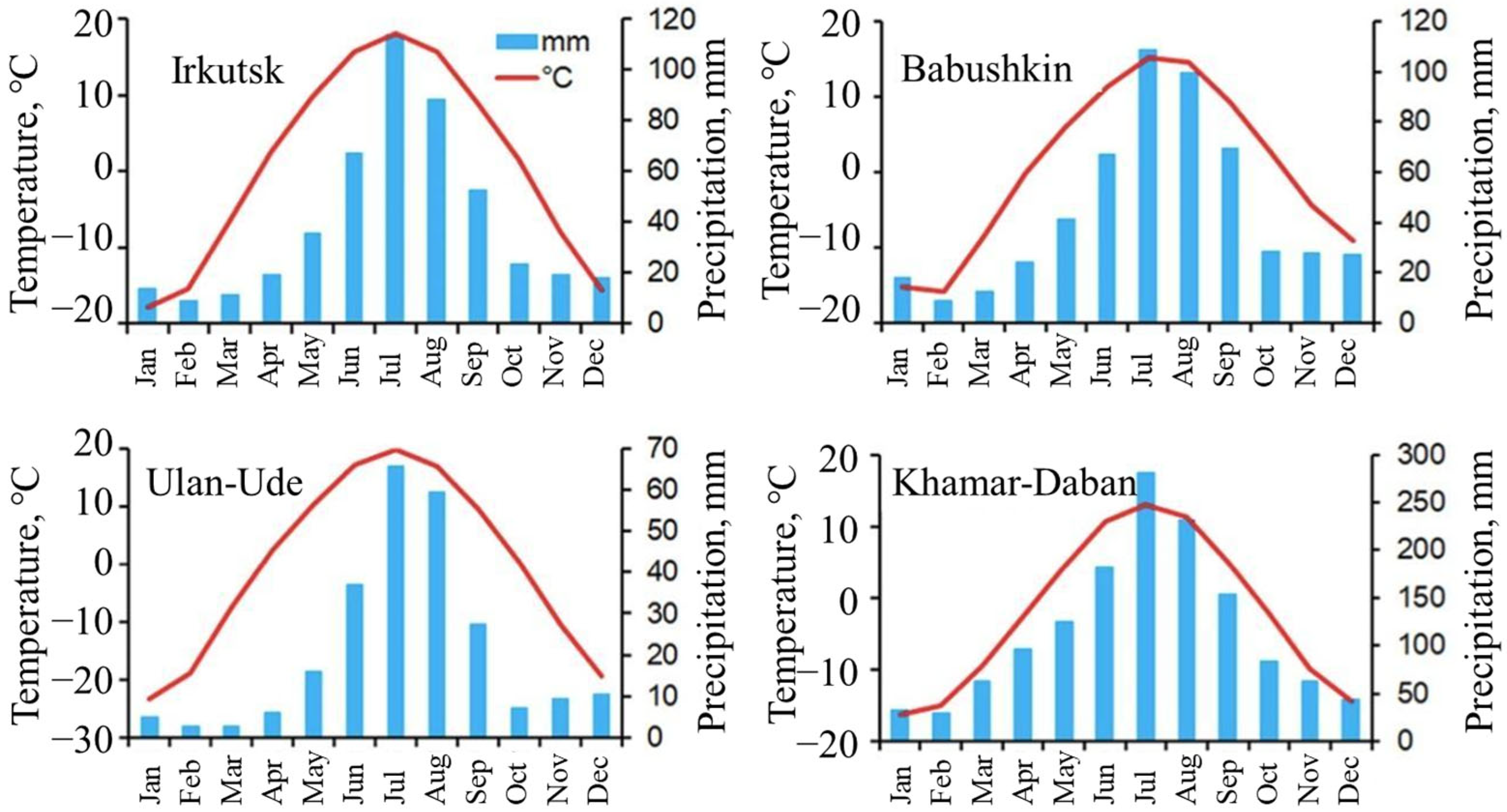

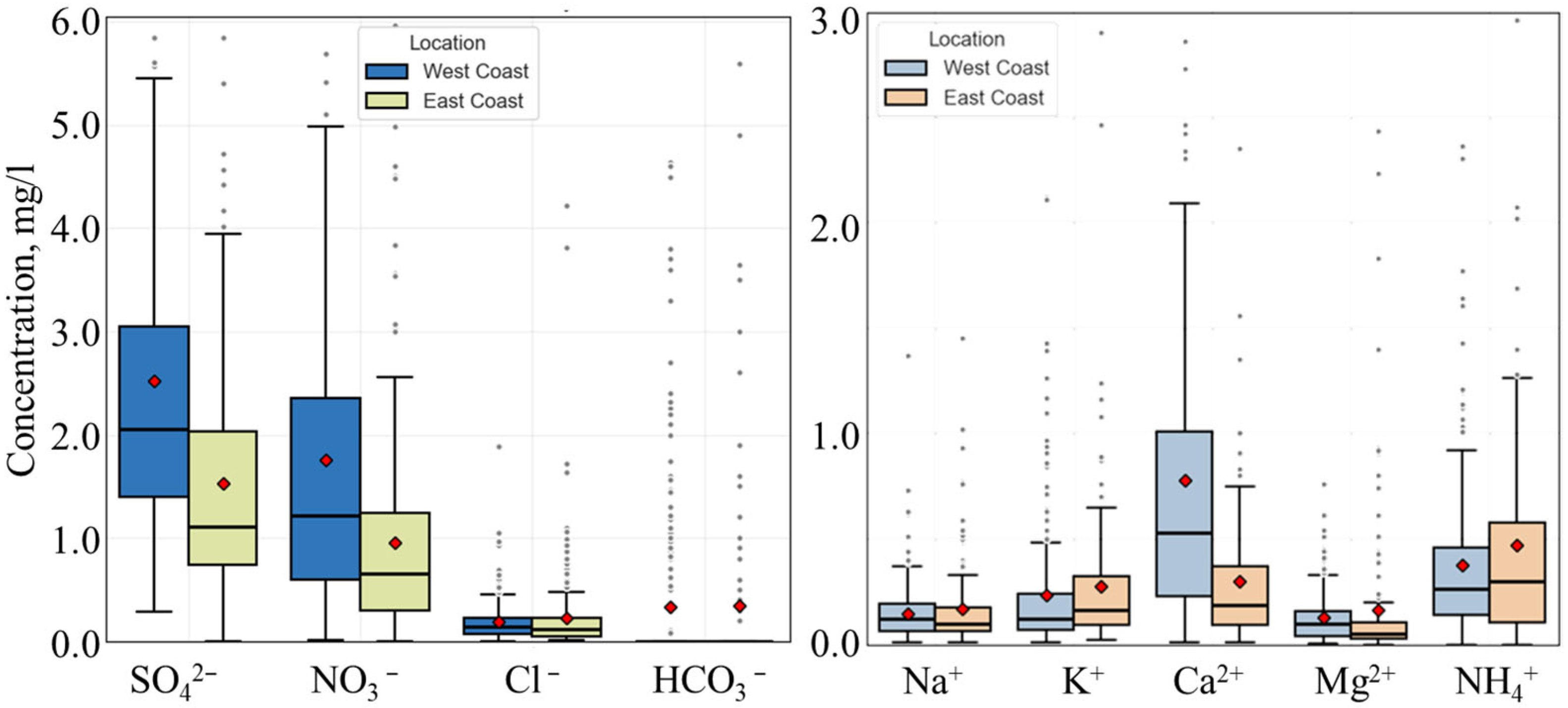
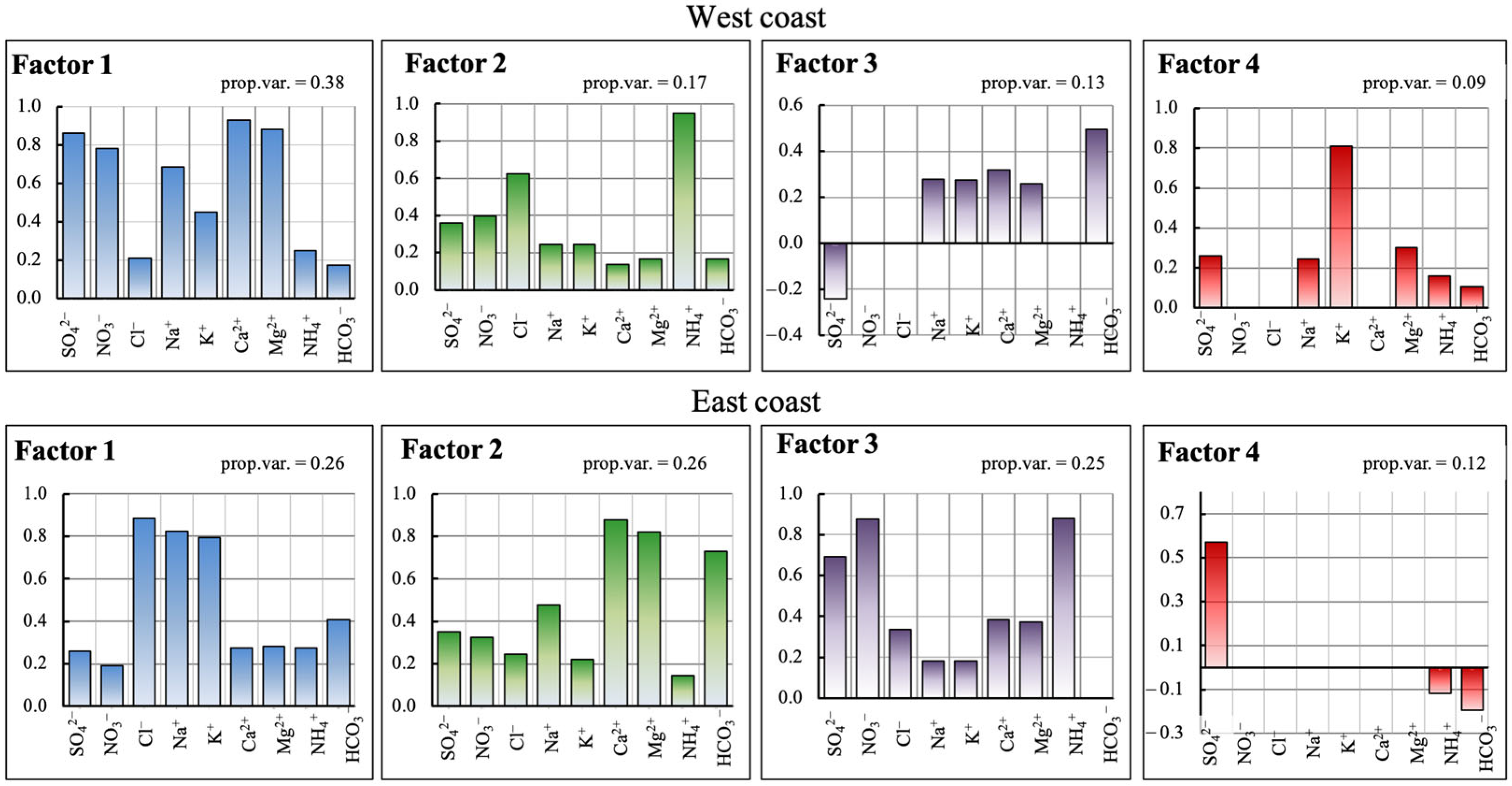
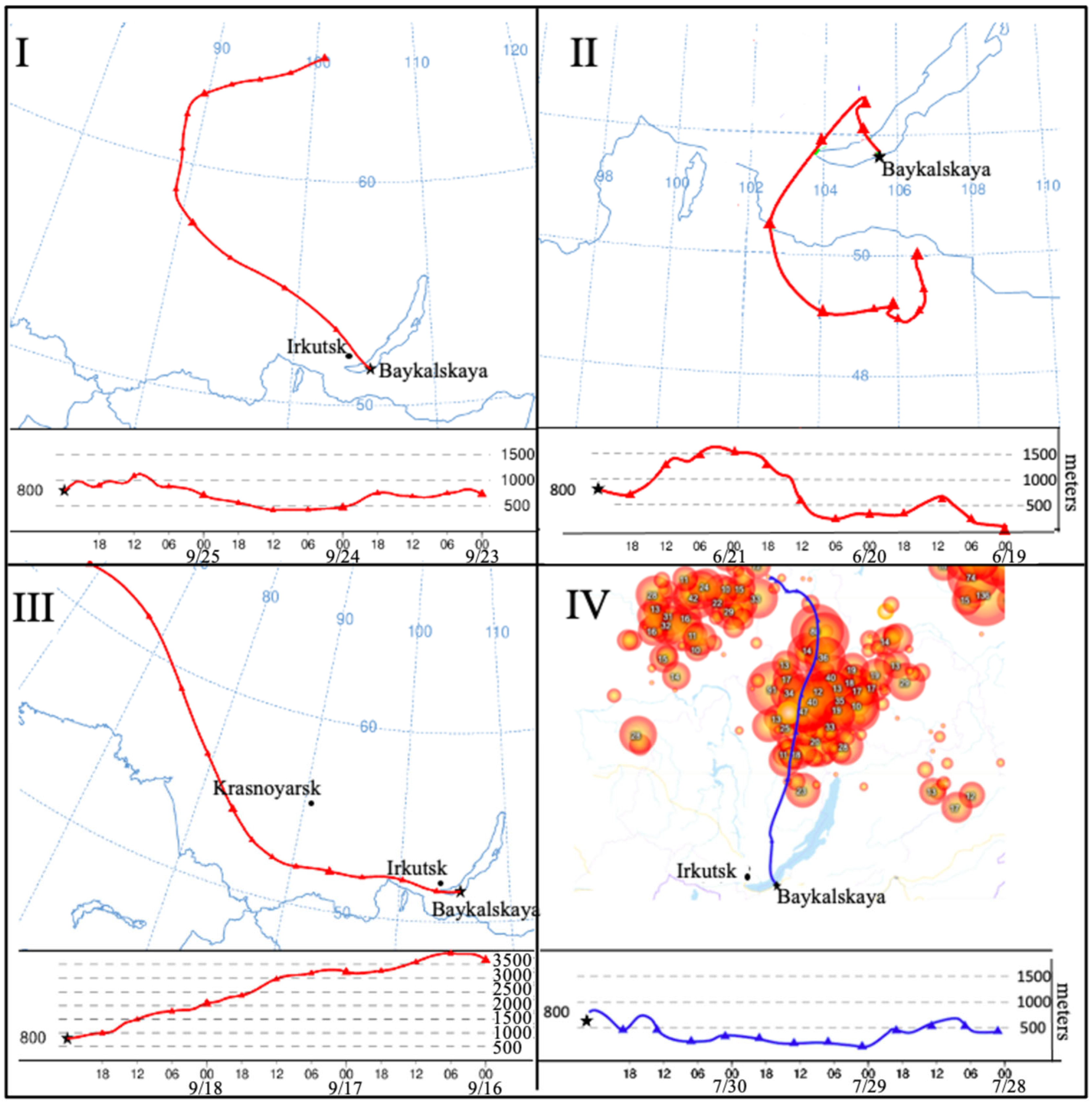
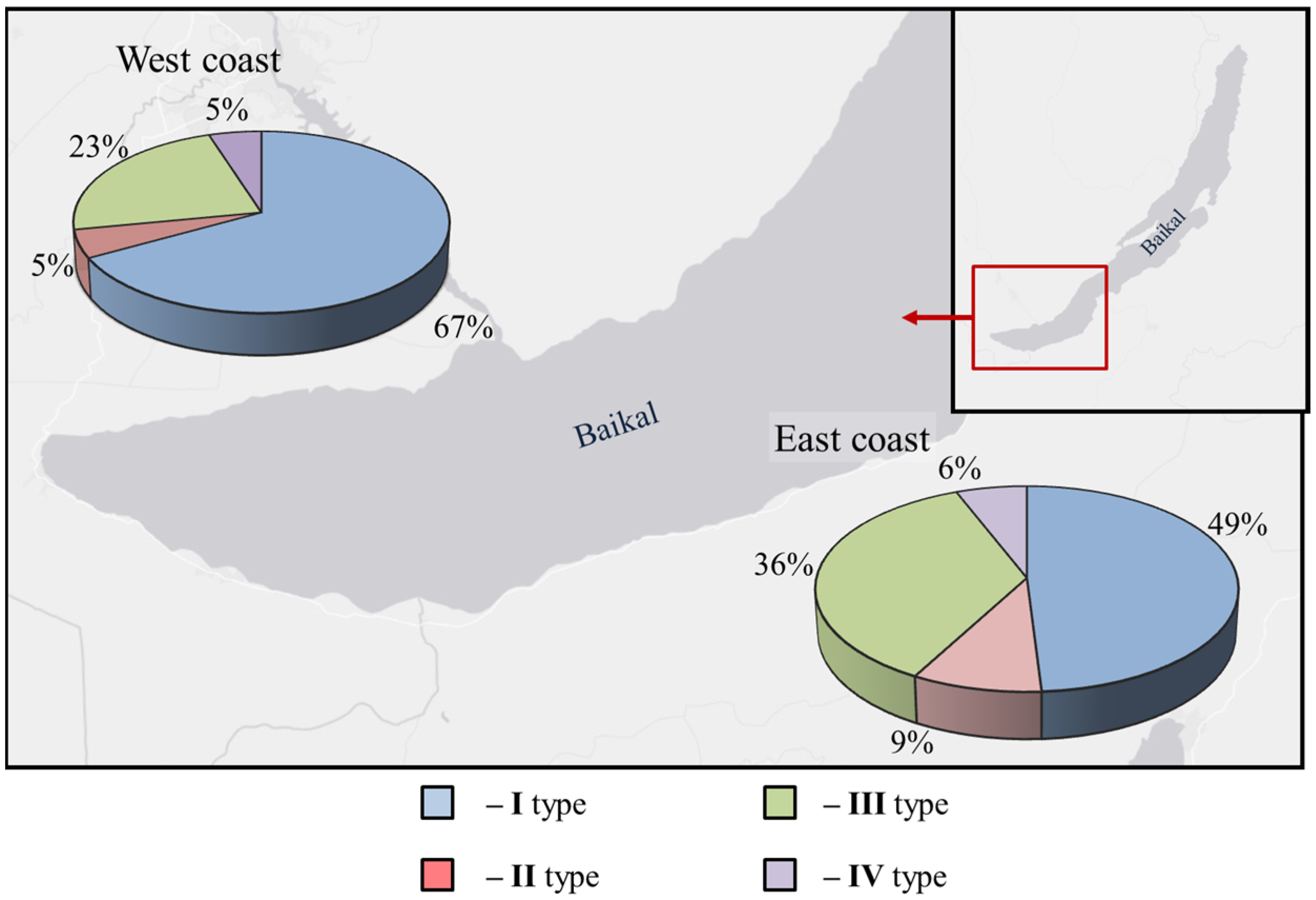

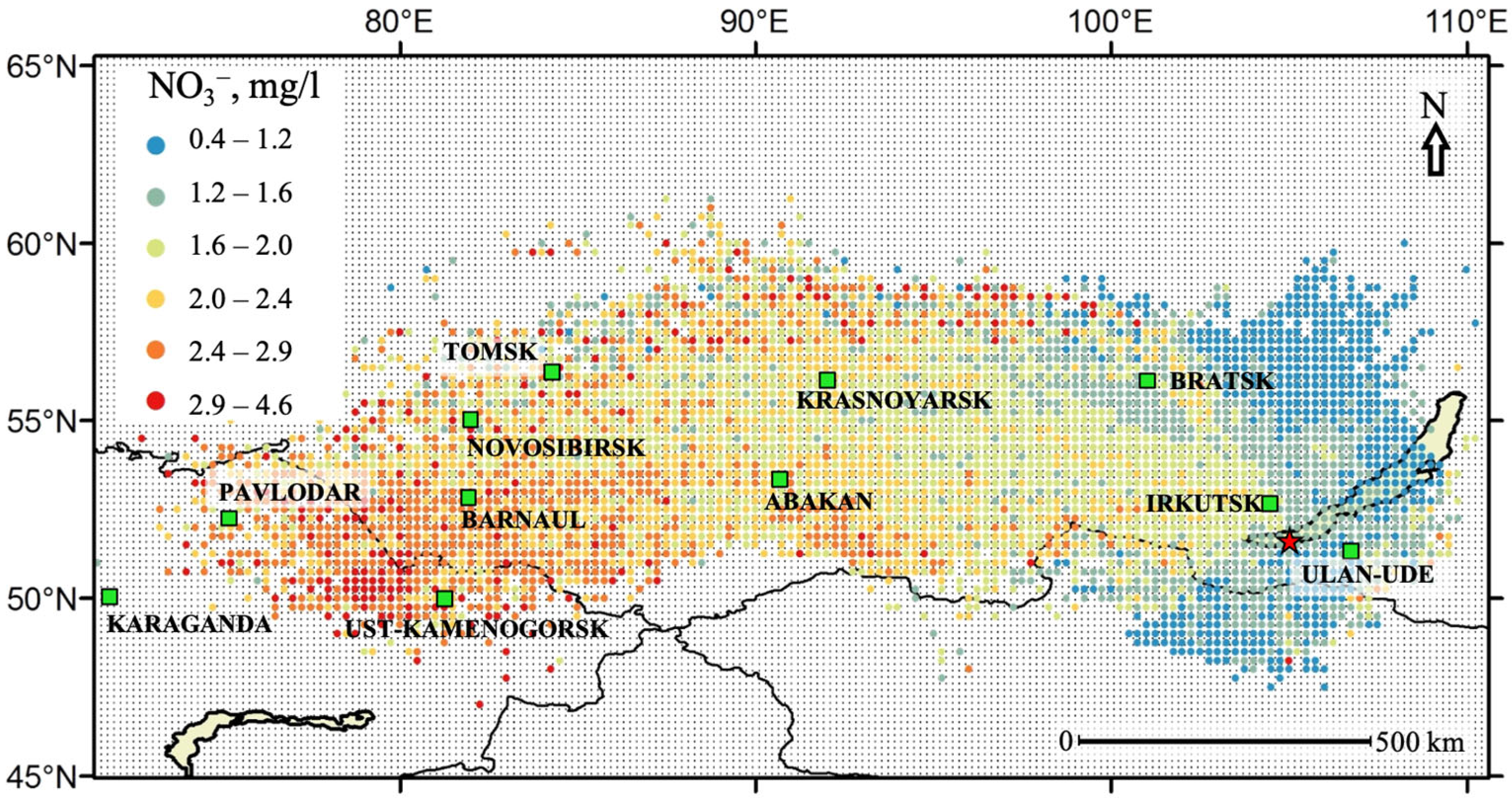
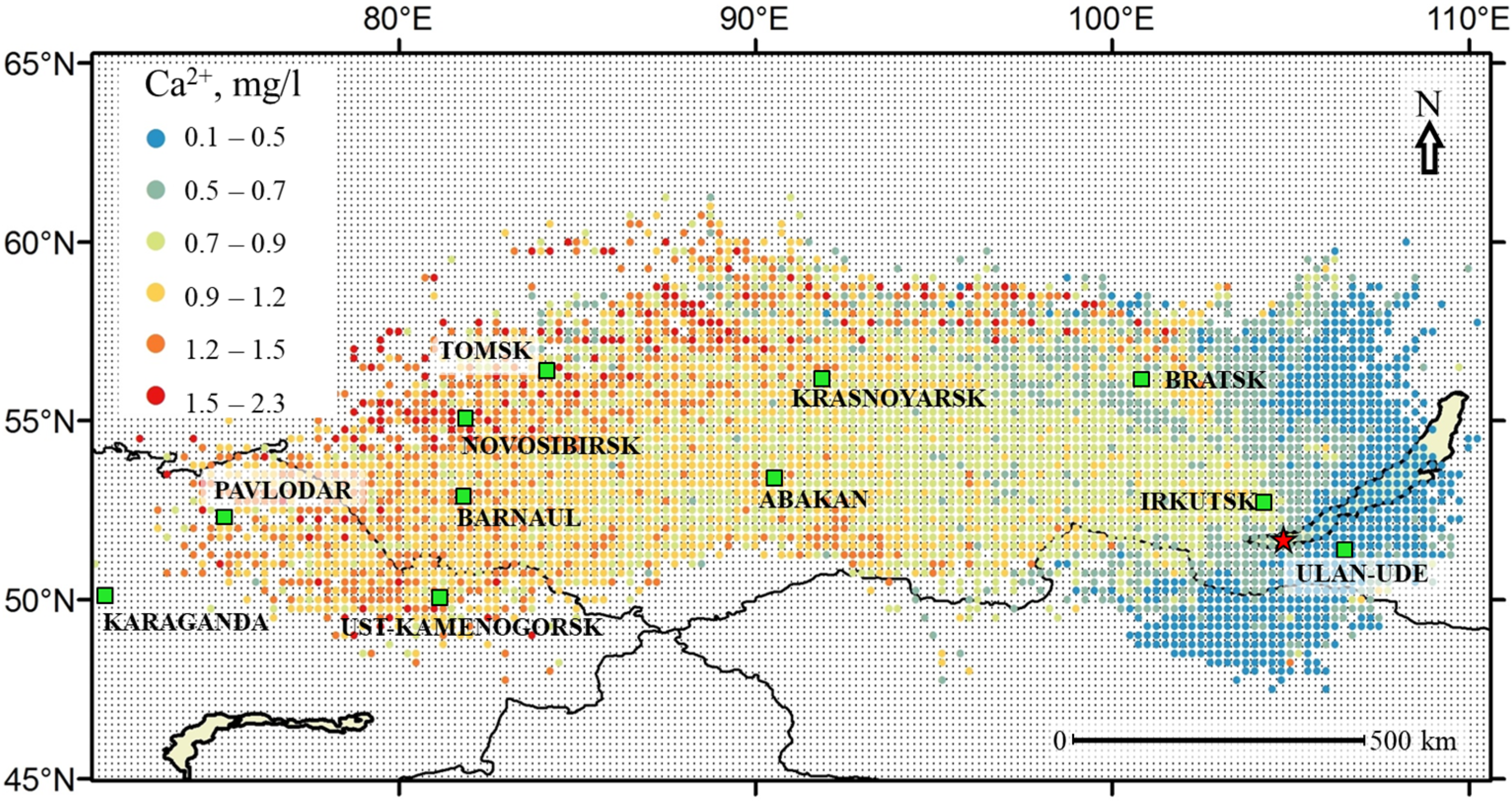
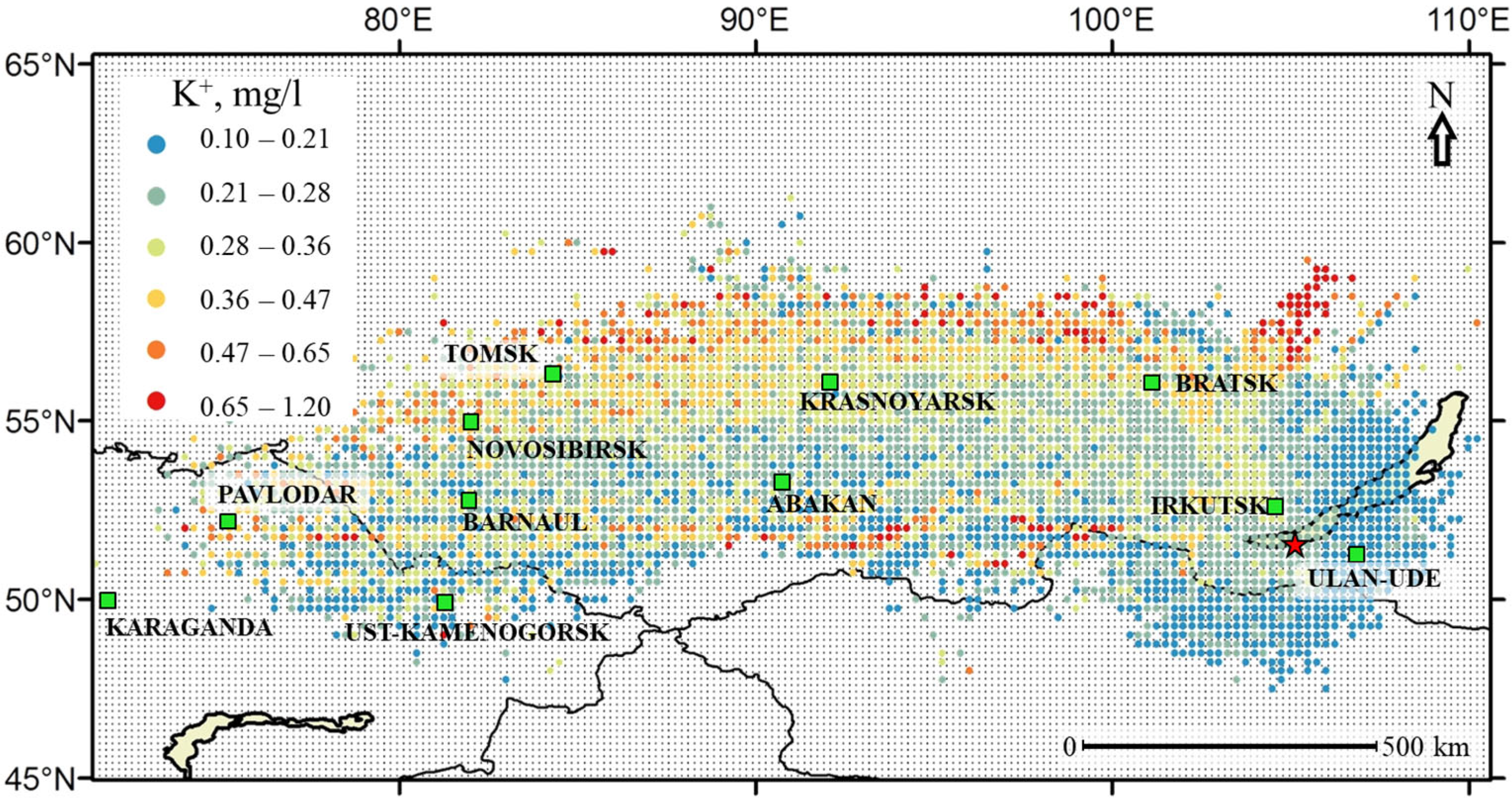

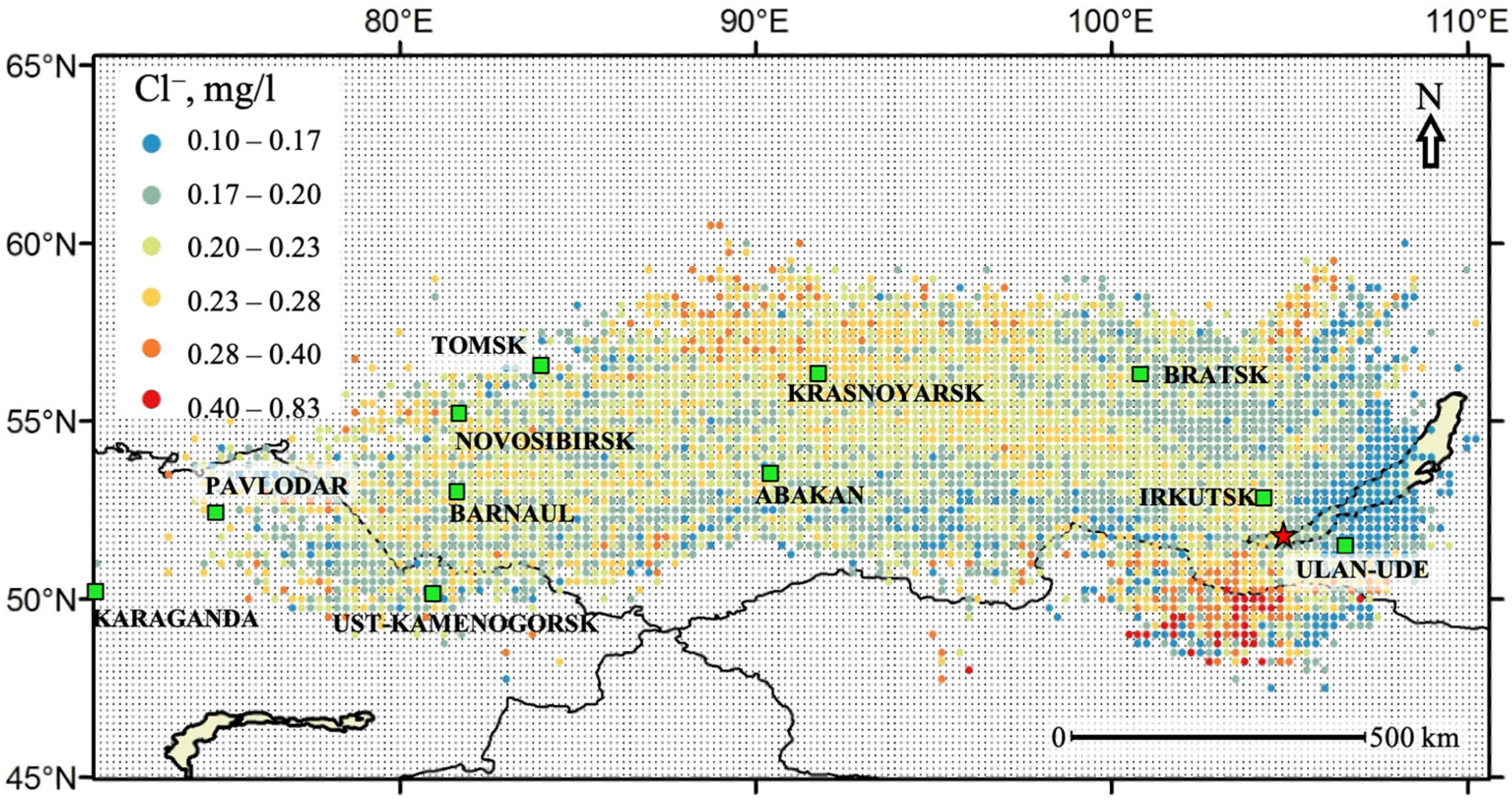
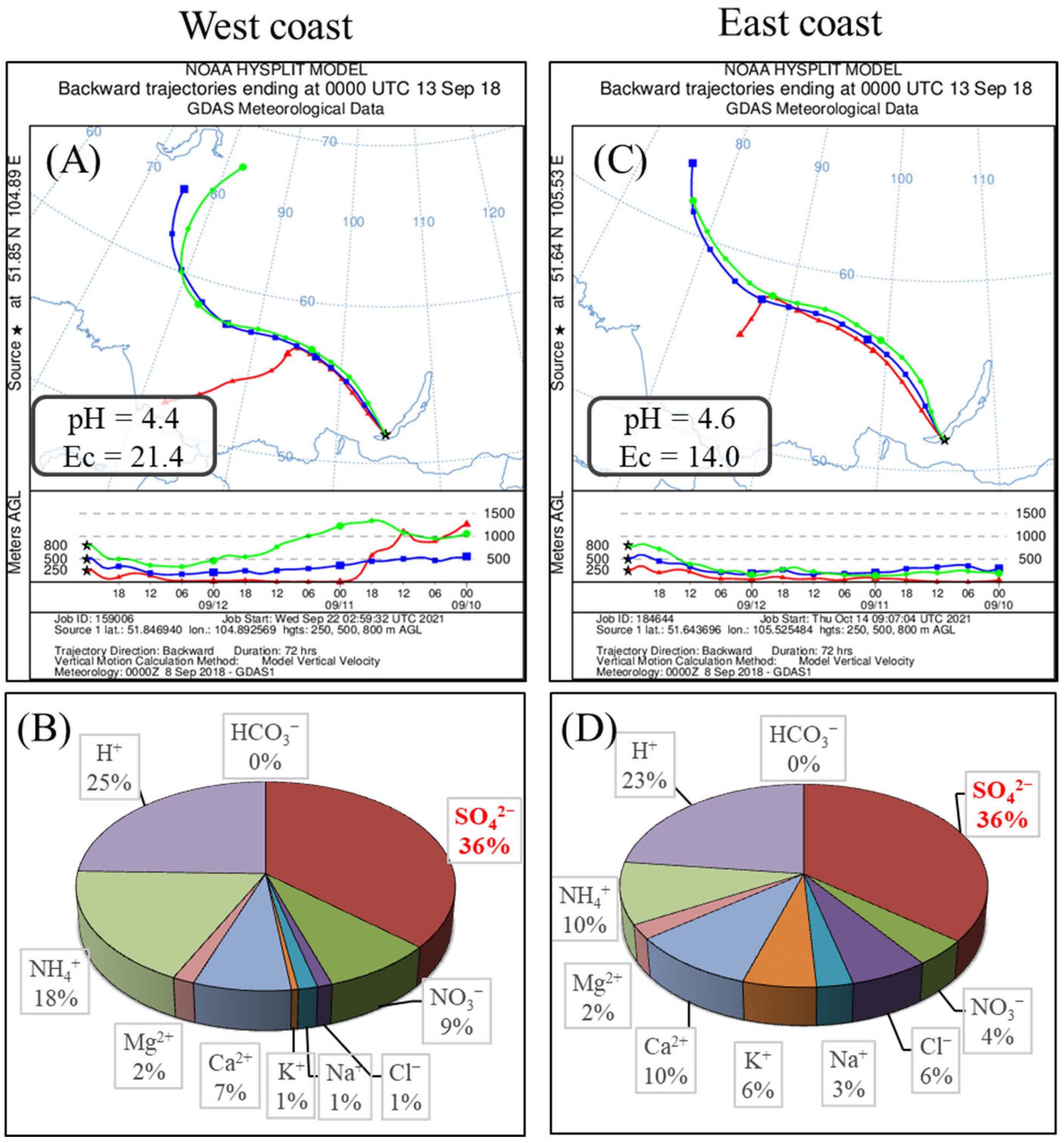
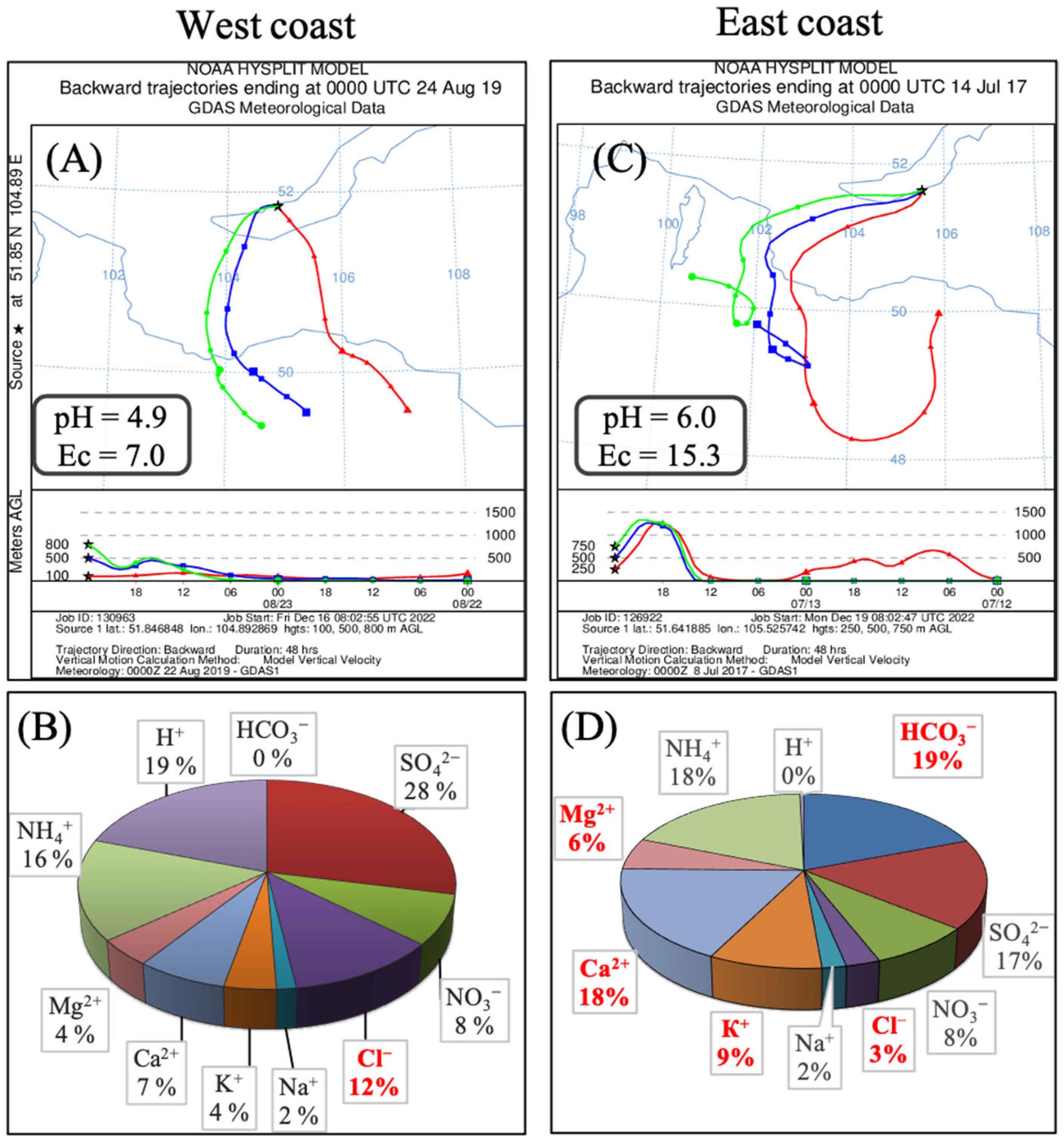
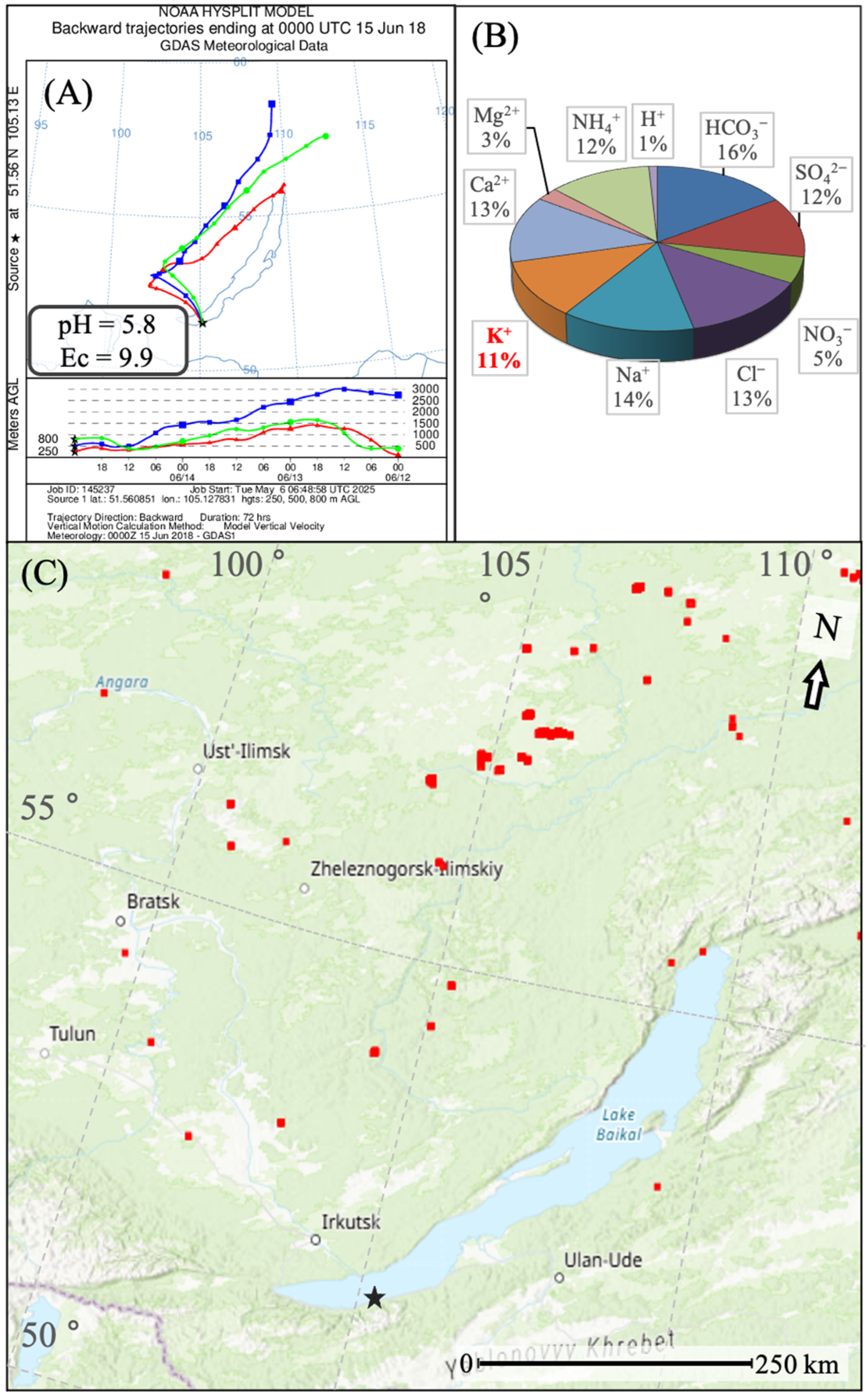
Disclaimer/Publisher’s Note: The statements, opinions and data contained in all publications are solely those of the individual author(s) and contributor(s) and not of MDPI and/or the editor(s). MDPI and/or the editor(s) disclaim responsibility for any injury to people or property resulting from any ideas, methods, instructions or products referred to in the content. |
© 2025 by the authors. Licensee MDPI, Basel, Switzerland. This article is an open access article distributed under the terms and conditions of the Creative Commons Attribution (CC BY) license (https://creativecommons.org/licenses/by/4.0/).
Share and Cite
Molozhnikova, Y.; Shikhovtsev, M.; Kalinchuk, V.; Netsvetaeva, O.; Khodzher, T. Determination of the Main Factors Influencing the Chemical Composition of Atmospheric Deposition in the Territory of the Southern Baikal Region (Eastern Siberia, Russia). Sustainability 2025, 17, 6062. https://doi.org/10.3390/su17136062
Molozhnikova Y, Shikhovtsev M, Kalinchuk V, Netsvetaeva O, Khodzher T. Determination of the Main Factors Influencing the Chemical Composition of Atmospheric Deposition in the Territory of the Southern Baikal Region (Eastern Siberia, Russia). Sustainability. 2025; 17(13):6062. https://doi.org/10.3390/su17136062
Chicago/Turabian StyleMolozhnikova, Yelena, Maxim Shikhovtsev, Viktor Kalinchuk, Olga Netsvetaeva, and Tamara Khodzher. 2025. "Determination of the Main Factors Influencing the Chemical Composition of Atmospheric Deposition in the Territory of the Southern Baikal Region (Eastern Siberia, Russia)" Sustainability 17, no. 13: 6062. https://doi.org/10.3390/su17136062
APA StyleMolozhnikova, Y., Shikhovtsev, M., Kalinchuk, V., Netsvetaeva, O., & Khodzher, T. (2025). Determination of the Main Factors Influencing the Chemical Composition of Atmospheric Deposition in the Territory of the Southern Baikal Region (Eastern Siberia, Russia). Sustainability, 17(13), 6062. https://doi.org/10.3390/su17136062






